To survive during tough times you need 2 things: a loyal brand and multiple streams of revenue. In this post, we'll show you how to do both.
Anyones who’s ever started a restaurant, cafe, or eatery knows it’s no walk in the park. Although it can be a challenge to start and get a restaurant business up and running, it’s often an extremely rewarding experience.
But with millions of eateries around the world, how do you stand out from the crowd? More importantly, how do you create a loyal customer base that continues to come back and spread the word of your business? And along with that, how do you give yourself a defensive shield when things go south?
14 marketing strategies to increase restaurant revenue
In this post, we’ll show you 14 different ways you can create new revenue streams, drive awareness to your business, and build a brand that creates returning customers.
1. Add or move to a takeout model
With the rise of takeout delivery apps like Uber Eats, Postmates, DoorDash, GrubHub, and many more, it’s more important than ever to have your restaurant, cafe, or eatery listed on one of these apps.
This is because the way people buy and consume food is changing — call it, a change in consumer behavior (no pun intended). The truth is, smartphone food delivery app usage is on the rise. And with the most recent pandemic hitting our globe, it shows just how powerful and useful these apps can be when customers can’t leave their homes.
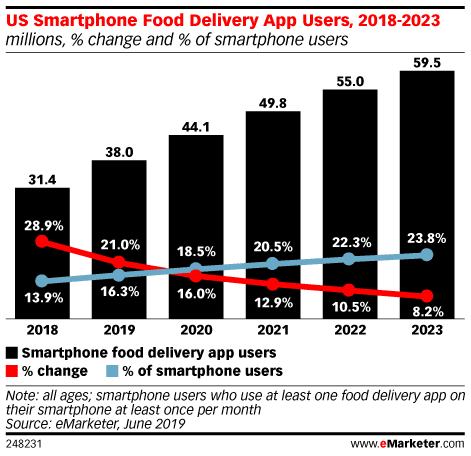
We are living in the era of convenience. Consumers will pay a premium if something can save them time, while also being extremely easy to use.
Delivery apps and takeout models do just this. They make it extremely easy for someone to take out their phone, select a restaurant of their choice, and wait until someone drops it off at their home.
So knowing how consumers behave, while also taking into account the current situation of our economy, it only makes sense for many restaurants, cafes, and eateries to think about establishing a takeout model.
Delivery apps also do a great job at marketing to their users and encouraging them to use their apps more and more. As a restaurant owner, joining one of these apps can help increase the awareness of your business.
How to become a partner on a delivery app
Signing up to be a partner with any of the popular food delivery apps is a fairly simple process. However, note that the time it takes to get approved on these apps can vary depending on how many store locations you have and which apps you decide to sign up with.
To get started, simply apply to be a restaurant partner by clicking any of the links below:
Whether it’s signing up to be a partner for a delivery app, or building out the infrastructure to create your own delivery service, adding or moving to a takeout model can help you serve more customers and add as a new revenue stream.
2. Create a website to grow your brand
Modern day marketing calls for establishing a meaningful brand. As a restaurant, branding is extremely important given that competition for attention is high. Many restaurants and cafés either don’t have a website at all or have a very minimal one that serves no real purpose.
If you don’t already have a website, I encourage all businesses to go out and at least buy the domain name of their business. But don’t just stop there. Creating a web presence for your restaurant can bring you a plethora of opportunities to not only market and bring awareness, but to also generate extra sources of revenue.
Assuming you follow website SEO best practices, creating a website for your restaurant, café, or eatery will give you the opportunity to show up in Google search results.
Chances are, if you don’t have an established website, and someone were to look up the name of your restaurant in Google, a Yelp or TripAdvisor listing may show up. However, if you have a website up and running, your website will show up first. This is important because you own your website. Meaning, you have the opportunity to show potential customers more information than, say, a Yelp review could.
We can see this with Miss Lily’s, a Jamacian restaurant in New York. If you were to Google “miss lily nyc,” their website is the first result. And on their website you’ll find things like menus, their brand story, locations, and even delivery options
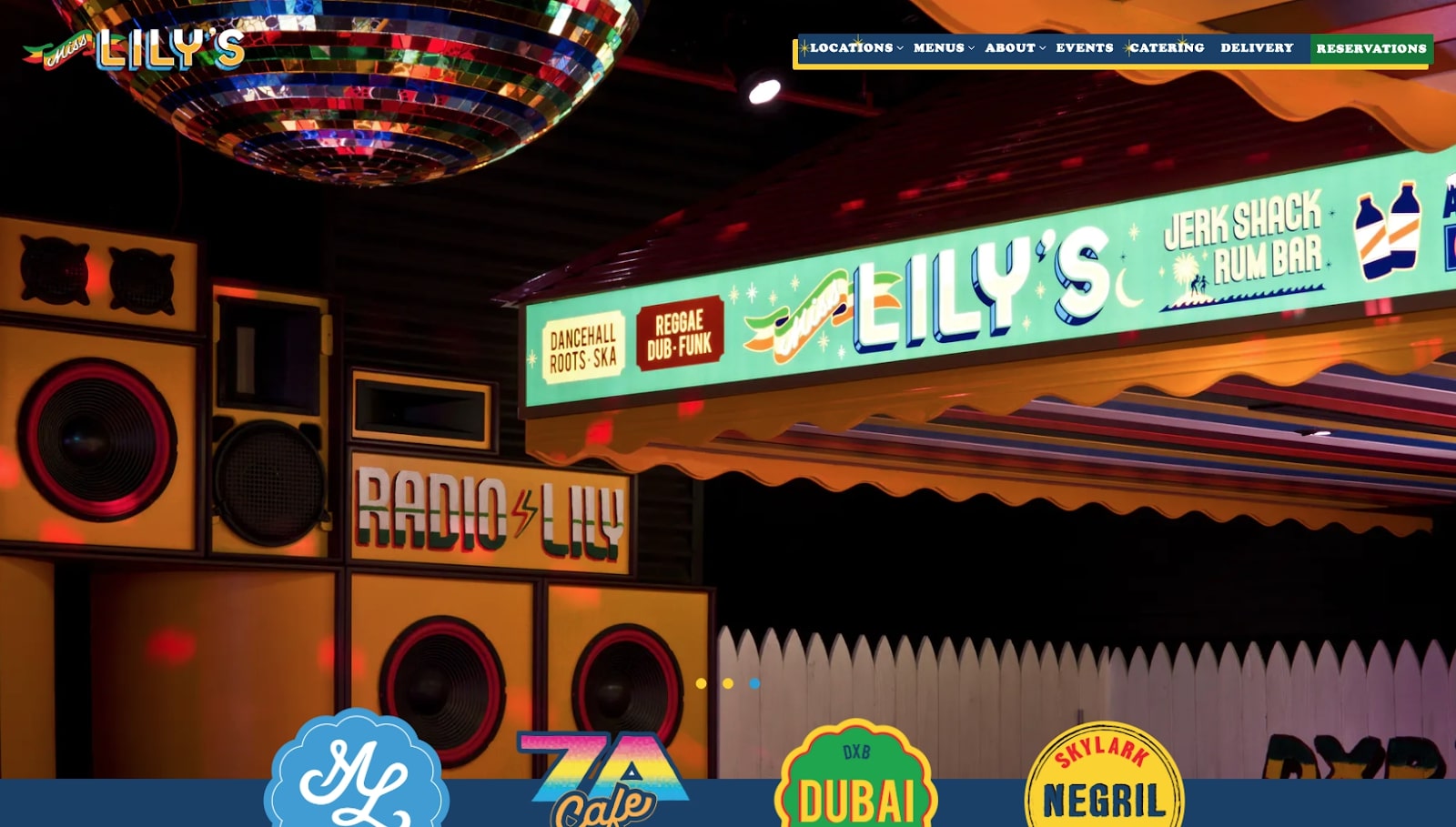
Creating a website can also make it easy to spread awareness of your business through social media. For example, if you partnered with a “foodie,” or influencer, you can have them promote your website URL — making it easy for people to discover your business.
Creating a website will also give you the opportunity to drive more revenue by being able to sell items directly on your website, whether it's recipes or merchandise, and gives you the opportunity to remarket to your previous customers through email marketing.
We’ll get into more detail on what I just mentioned above, but the bottom line is creating a website will open a lot of marketing doors for your business — all opportunities to stand out.
Related reads: 21 restaurant website design examples
3. Start a blog
You probably already know what a blog is, so I’m not going to go too much in detail about how to make one. I just want to show you how powerful a blog can be in the food industry.
Let’s say your restaurant has amazing cocktails on its menu. Maybe you have the best San Francisco Cocktail in town. You could write a blog post explaining the story behind it and how you make it. In other words, you could start creating recipes for various menu items. And if you were to write an awesome post on ”how to make a San Francisco Cocktail” that starts ranking in local search results, some of those visitors may actually live in San Francisco and come check out your physical location (assuming you’re also located in San Francisco).
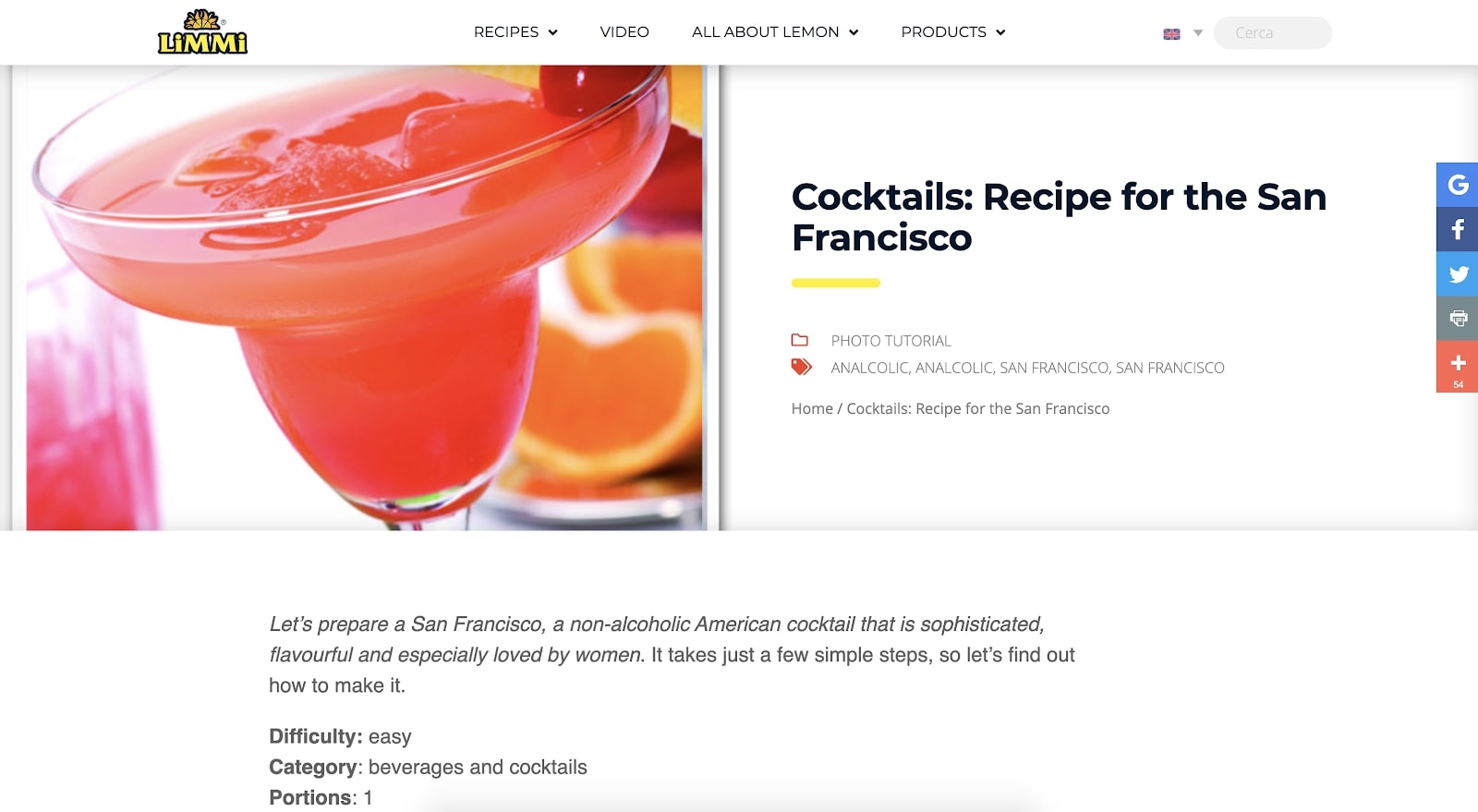
On top of that, you could create a full ebook of cocktail recipes and market that on your website as an additional revenue stream. This allows you to expand your brand and market your restaurant or café through the power of content marketing.
But above all, creating a blog will give you a medium to communicate your brand to the world. Humans are storytellers, and we all love a good story — so tell yours! Businesses that create content frequently are able to give their brand a strong voice, ultimately affecting their bottom line. It’s not often that you’ll come across a really nice blog from a restaurant, café, or eatery, so there’s a lot of opportunity to shine here.
Before starting your blog, make sure you know its purpose, who you’re speaking to, and have a content strategy that has a nice blend of driving local SEO traffic while creating engagement amongst your community.
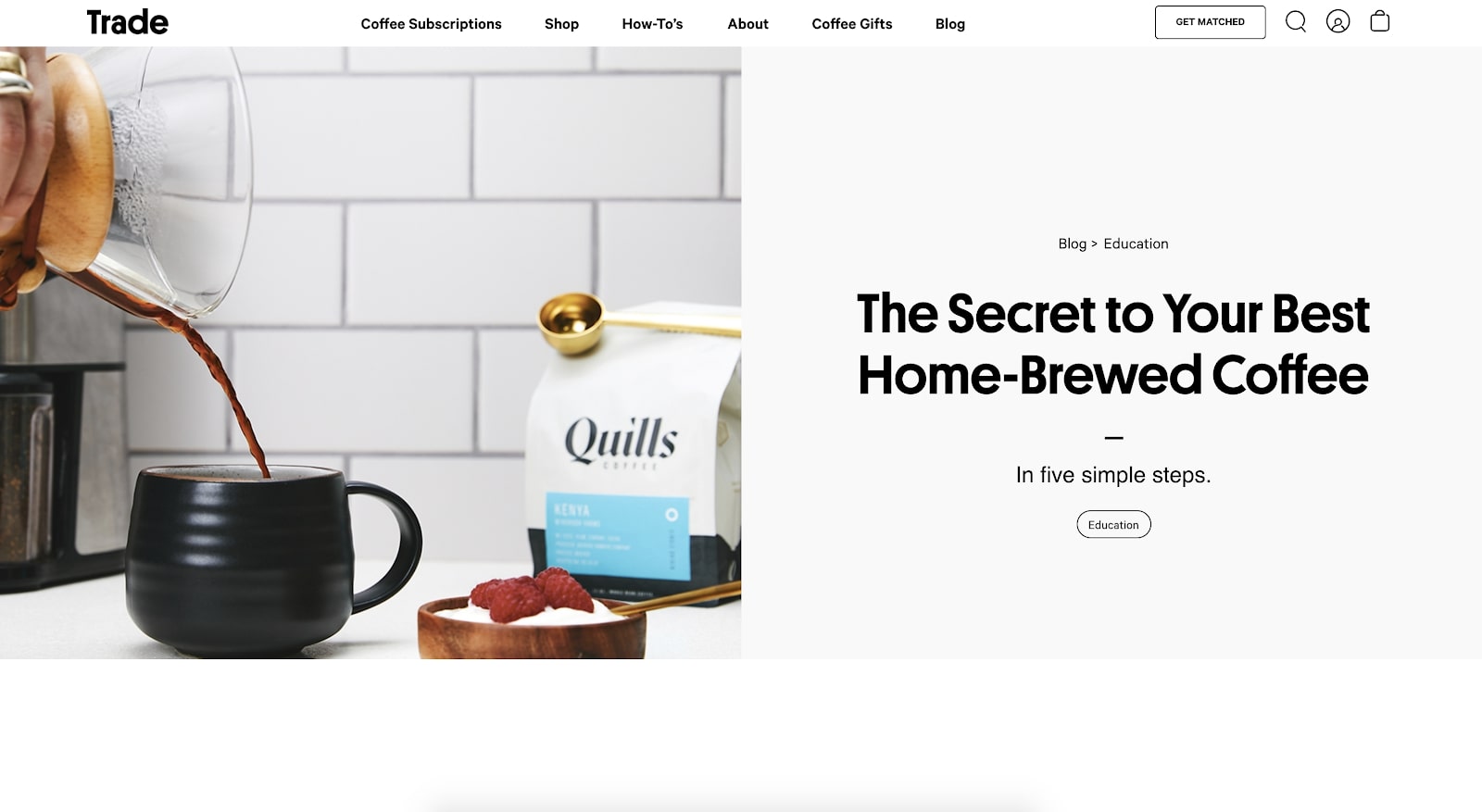
One of my favorite blogs from a food and drink company would have to be Trade Coffee. Even though Trade Coffee is an ecommerce coffee subscription service, as a café, or restaurant, you can gain some serious inspiration from their marketing efforts.
4. Reach out to publications for a feature
Let’s say you don’t want to start a blog. Well, that doesn’t mean you can’t leverage other ones! You could simply reach out for a feature on different publications. However, before you do something like this you’ll want to make sure your food is of utmost quality, and that you already have a nice looking website up and running. These will greatly increase your chances of getting a response.
This is a really powerful thing you can do to drive awareness to your restaurant business because there are plenty of blogs and publications out there that review restaurants, cafés, and other eateries. And these blogs always need content to write. Just reach out to them and ask how you can get featured, or how you can contribute — it never hurts to ask.
I know it’s easier said than done, so let me give you a practical example for how you can get started.
Let’s say you’re a restaurant that makes Korean food and you’re located in Los Angeles, CA. Go to Google and search for “best Korean restaurants in Los Angeles” and see what comes up.
Make sure you click on listings that are blog posts, or articles, written by authors that have contributed to a publication. This is important because if a Yelp page shows up, you can’t really reach out to anyone.
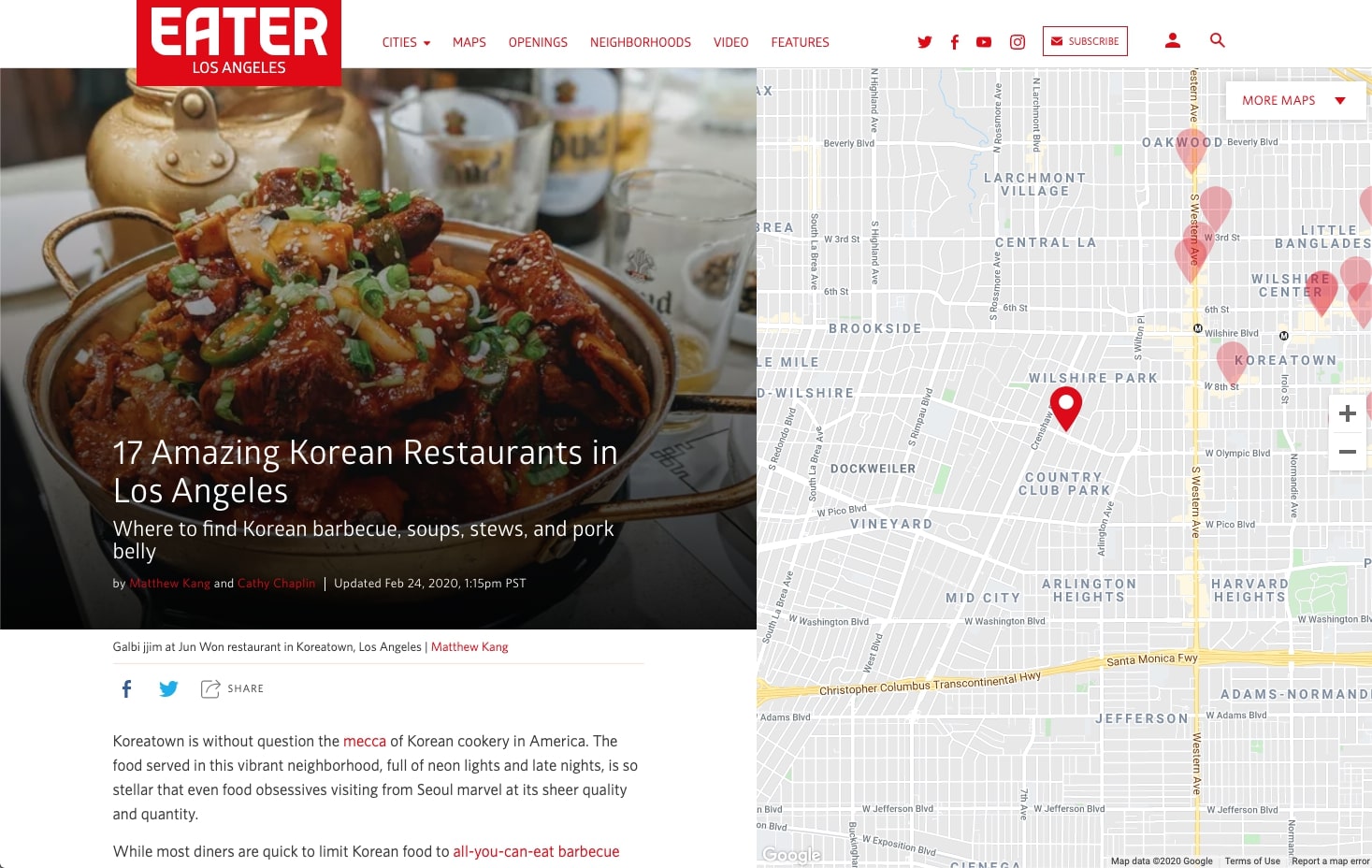
For the example of our Korean restaurant, a blog post from Eater Los Angeles shows up in search results. Upon looking at the article, we can see that the post is written by 2 different authors. That’s 2 different people you can reach out to to ask how you can be added to the list. In the case with Eater, you can click into the authors profile and see their email and social media profiles — places you can get in contact with them.
But of course, don’t just reach out asking to be featured without offering anything in return. Authors and editors get tons of emails from people asking for things like this, and you don’t want your email, or DM, to be lost in a sea of others. Instead, think about how you can bring value for that author or publication. Maybe in exchange for a feature, you can write an article about them on your website. Or you can write an article for their publication. Get creative with it! But the takeaway is, have something to offer if you’re going to ask. Make it a mutually beneficial opportunity.
5. Get on social media
Remember how we talked about branding being extremely important these days? Social media is your opportunity to give your brand a voice. People don’t buy from businesses, they buy from people — so give your business a human touch.
But don’t go out and create a bunch of social media accounts just to spam them with CTAs (calls to action) telling people to go buy your food.
Instead, be strategic with it. If you have a Facebook page, try sharing menu items, blog posts, or recipes on there. If you have an Instagram account, share images (and memes) of items you have to offer. And if you have a Twitter account, engage in conversations with your existing and potential customers
Having a strong social media presence can not only strengthen your brand, but it can also give you an opportunity to drive a lot of awareness. For example, people that either visit your restaurant, or get your food to go, may want to tag you in their Instagram stories or any other social media posts. This will allow others to easily find you and know what you have to offer.
On top of that, you can partner with social media influencers that can help you grow your social media accounts. More on that later.
6. Sell digital and physical products on your website
Running a restaurant, café, or eatery doesn’t mean your only source of income has to come from the food and drinks you offer.
Restaurant businesses that dive into the ecommerce world are able to create additional revenue streams they wouldn’t have thought possible. For example, you could create recipe books, in the form of physical books or digital downloads, for some of the most popular items on your menu.
And if you have a really strong brand, you can get creative and sell branded merchandise or DIY packages for different food and drink items you have to offer. For example, Shake Shack started creating DIY ShackBurger Kits so customers can start creating their own Shake Shack burgers at home — genius!
7. Sell gift cards and offer strategic discounts
Selling gift cards, and offering coupons and discounts, is a great way to spread awareness and drive upfront revenue.
Gift cards
In the sense of awareness, a customer may buy a gift card to give to friends or family. If that friend or family member had never heard of your business, now they do. And they have a reason to come try your food.
This has a great viral effect because if customers really like your restaurant or cafe, they’ll come back and eventually tell their friends about it. This is why when we talk about marketing ideas, it’s important that your restaurant offers great food to begin with, because word of mouth will do all the heavy lifting for you.
On the other end, gift cards also help you drive upfront revenue. The idea of “you pay me now and I’ll supply later” can literally save a business during tough times.
So bottom line, sell gift cards. Chances are if you’re getting gift card sales it means customers like what you have to offer and you’re doing something right.
Coupons and discounts
Coupons and discounts are also another great way to get customers to come back. But be careful here, you don’t want to rely heavily on this. Abusing coupons and discounts can make people question why you can’t just sell at a regular price and have to rely on discounted rates to get customers. It’s not a good look.
Instead, you can be strategic with this by using coupons as a tool to get existing customers to come back. For example, if you were to collect emails from customers, either through your website or physical location, you can send them occasional emails offering these discounts. Key word here is occasional. Don’t over do it.
8. Create an email newsletter
Building off the idea of sending emails, is starting an email newsletter. You can capture customer emails through a number of ways:
- An optional opt in form at a physical location
- Ask for it when a customer makes an order (if you have your own delivery service set up)
- Use emails from customers that purchased through ecommerce sales
- Gated content from recipes or ebooks on your website
Make sure customers opted into receiving promotional emails from you before you do any of the things listed above.
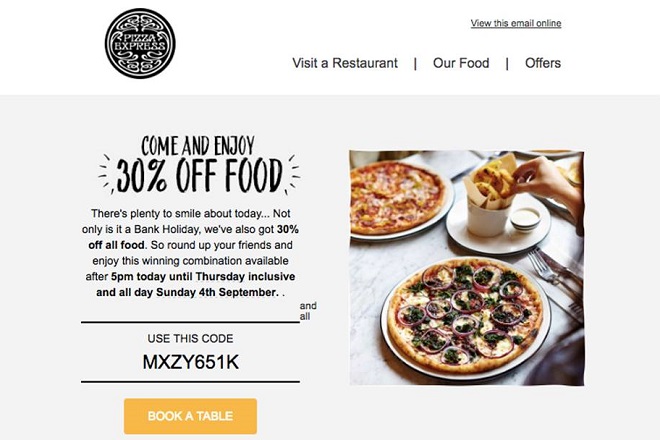
Once you have a list of emails, you can now create a marketing plan around what you want to send. You can send occasional discounts (as mentioned above), valuable content like blog posts, company updates, new menu items, and anything else you deem important to your user base.
Get creative with it, but don’t over do it. Use a tool like Iterable or Mailchimp to manage your email list(s), find the right balance of email frequency, and times to send emails for maximum open rates.
And as a bonus, try looking into SMS marketing. It’s been proven to be successful for many businesses.
9. Create profiles on restaurant discovery and review apps
Social proof is a huge driving force for decision making. While using social media is a great way to show the human side of your brand, it’s still done by you. As in, you call the shots for how you want your business to be perceived.
But much of consumer decision making runs on referrals and external reviews. In fact, 88% of consumers put the same weight on online reviews as they would from a family or friend recommendation. That’s huge.
So using restaurant review apps is a great way to give potential new customers the opportunity to make a decision. On the same token, adding your business to one of these apps can help you gain awareness from other users browsing the app.
A few apps to consider adding your restaurant, café, or eatery to would include:
- Yelp
- Urbanspoon
- Zagat
- Restaurant.com
- Foursquare
- TripAdvisor


















10. Create a Google My Business account
Making sure your business shows up on Google Maps is extremely important. Many consumers look for restaurants or cafés local to them by doing a simple search on their smartphone. This means making sure your restaurant pops up on Google Maps could make the difference from someone choosing your business or a competitors’.
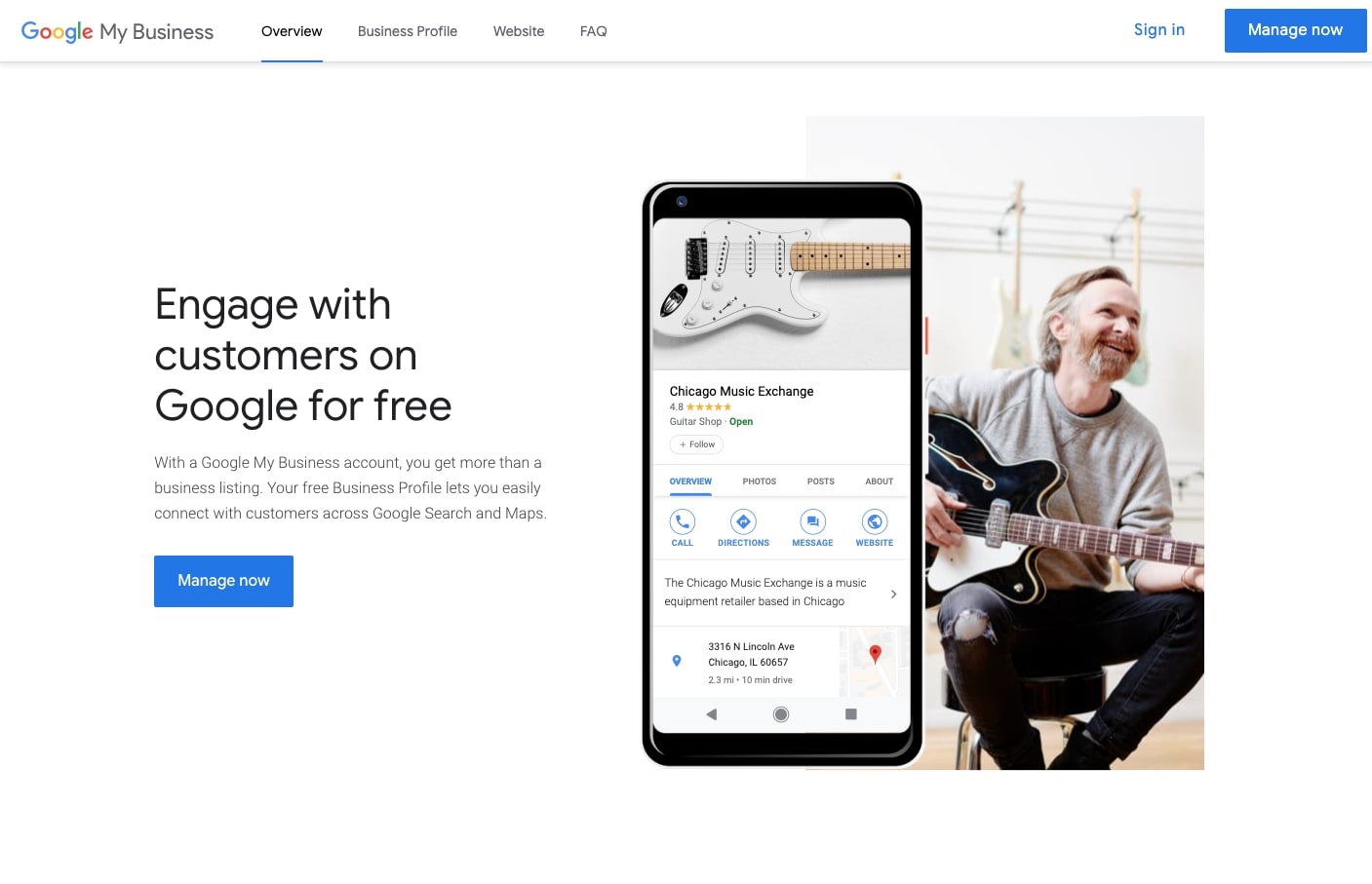
On top of that, setting up a Google My Business account doesn’t just give you the opportunity to show up on maps. It gives potential customers quick access to things like your menu, phone number, website, and options to message you. I personally use Google Maps to locate the phone number of local businesses, and I know I’m not the only one.
Signing up for Google My Business is as easy as visiting their website, clicking “manage now” and starting the application process. With as many as 5B monthly searches for restaurants and 5M monthly searches for coffee shops, there’s no excuse to not have your business listed on Google.
11. Start a YouTube channel
If you’ve made it this far down the list so far, congrats. This is probably one of the most underrated ways to market your restaurant, café, or eatery. I say this because YouTube is the second largest search engine in the world, right behind Google. And internet users love video — in fact, 85% of them.
YouTube, in my opinion, is also a much easier way to drive awareness to your brand. Not easier in the sense of content creation, because creating videos does take a lot of time, but in the sense of competition.
Earlier we talked about starting a blog. And while I think that is still very important, the truth is there’s a lot of competition in written content. It’s a lot easier to write a blog post compared to creating a video, so most businesses will write instead of investing time into video. Not to say that there's no competition in video, there is. It’s just a lot less than written content.
So how would you even start with YouTube for a restaurant business? Do the exact same things we mentioned in the blogging section of this post. Instead of writing a blog post about “how to make a San Francisco Cocktail,” record a video on the topic and upload it to YouTube.
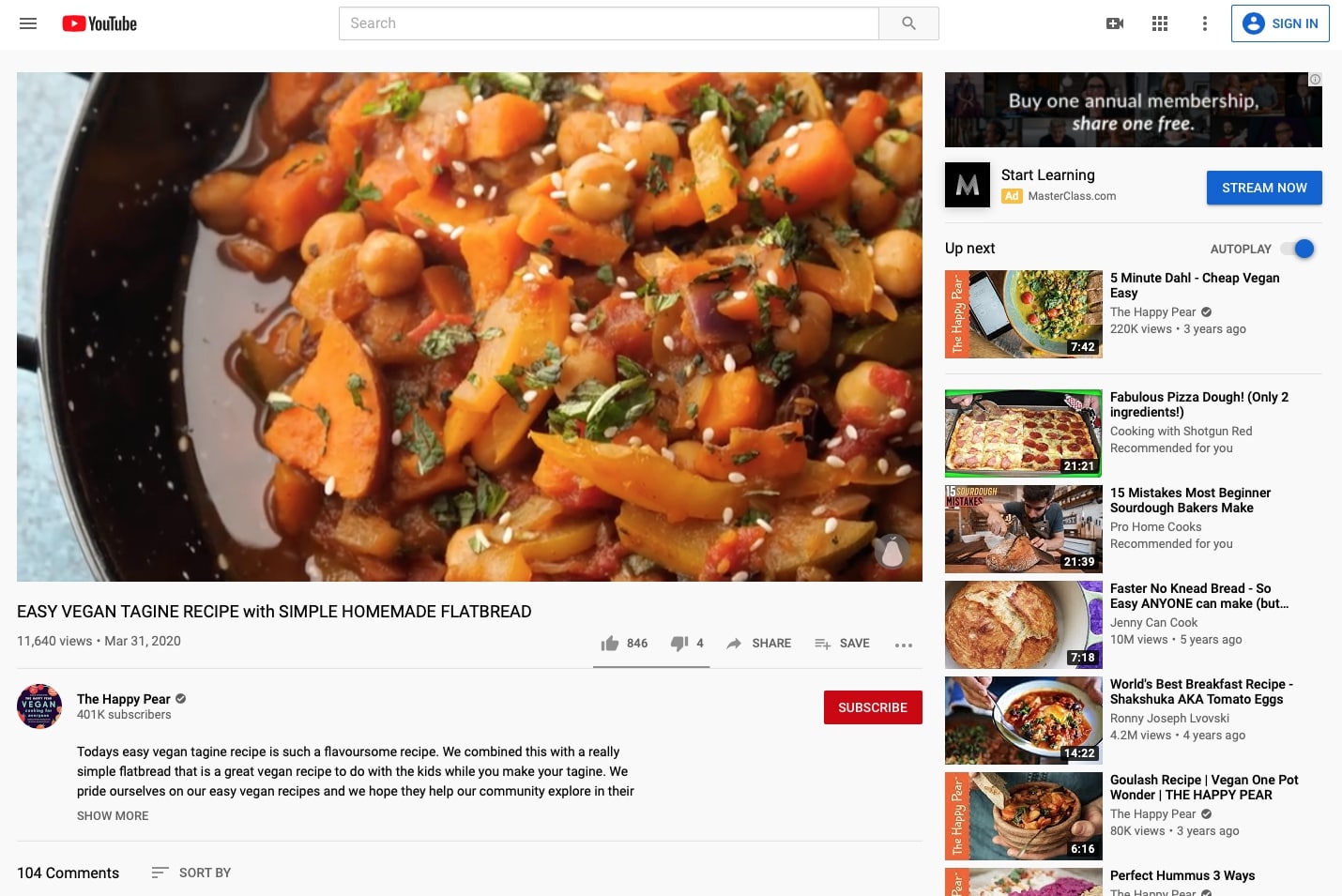
Create recipes tutorials, show how and why you started your business, and tell your company story. Today, people are at home more than ever and consuming tons of video content. You can use this as an opportunity to start a YouTube channel.
Quick and dirty guide to YouTube growth
To keep it short to the point, I’ll show you how to grow your YouTube channel with 3 main principles:
- Create a great title and thumbnail to drive clicks (needs a high CTR).
- Create videos with a high watch time and engage with your comments.
- Have keyword rich titles, descriptions, and tags to drive views through search.
The first 2 are pretty self-explanatory. Make sure the thumbnail and title looks appealing enough for someone to want to click on the video, Make sure people watch your video as long as possible by bringing them value in the form of education or entertainment, and encourage viewers to comment. These are the main principles for making videos go viral on YouTube.
The 3rd one follows YouTube SEO best practices. This will ensure that you don’t just rely on the possibility of going viral. You want your videos to show up in search results when someone looks up, say, a recipe. And to strengthen your SEO efforts, turn your videos into blog posts that you can then interlink. As in, embed your videos in blog posts on your website, and put links to your blog posts in your video descriptions.
To help with your research and SEO efforts, on YouTube, download the vidIQ Chrome extension. It will give you really good insights like what tags other videos are using, how competitive different topics are, and much more.
YouTube as another revenue stream
Besides creating videos to drive awareness, YouTube can be a new revenue stream — while boosting your existing ones.
For example, if you’re a café, you could create a video on “how to make coffee without a coffee maker.” And in that video you could show someone making coffee using the coffee that you sell in your physical or ecommerce store. Not only have you now given value to a viewer by teaching them something, but you’ve opened the door for them to go purchase coffee from your business. And if a viewer is local, they may be more inclined to come purchase coffee from your physical location.
On top of that, YouTube has a Partner Program that allows you to receive money from ads. So if your videos start to take off, you now have an extra revenue stream. Nice.
12. Explore influencer marketing
Influencer marketing is extremely powerful. Many businesses today are built solely on this alone.
This will call for you to reach out to influencers and foodies on social media and YouTube to collaborate. It could be as simple as paying an influencer to retweet one of your tweets, and as complex as having a well known chef create your most popular dish on their YouTube channel.
It’s important to note that the influencer marketing industry has been growing for a while now, so it’s important to vet who you want to work with. Just because someone with 100,000 Instagram followers posts a picture of your most popular dish doesn’t mean you’ll have customers flooding your door. Relevancy and engagement are key to making influence marketing work for you.
Make sure any influencers you work with have worked with other restaurants, cafés, or eateries in the past. And make sure they have an engaged following. As in, if an Instagram or any other social media account has 100,000 followers, but only a couple hundred likes per post, it means their engagement is really low and maybe not worth your time to collaborate with.
For more details on how to make influencer marketing work, check out Think Media’s video below:
13. Create a referral or affiliate program
Referral and affiliate programs are a great way to bring customers to your business. This is mainly due to the fact that they encourage repeat customers, and much of the marketing work is done by your partners and customers. Both programs can be great, but they serve different purposes. Let’s go over them.
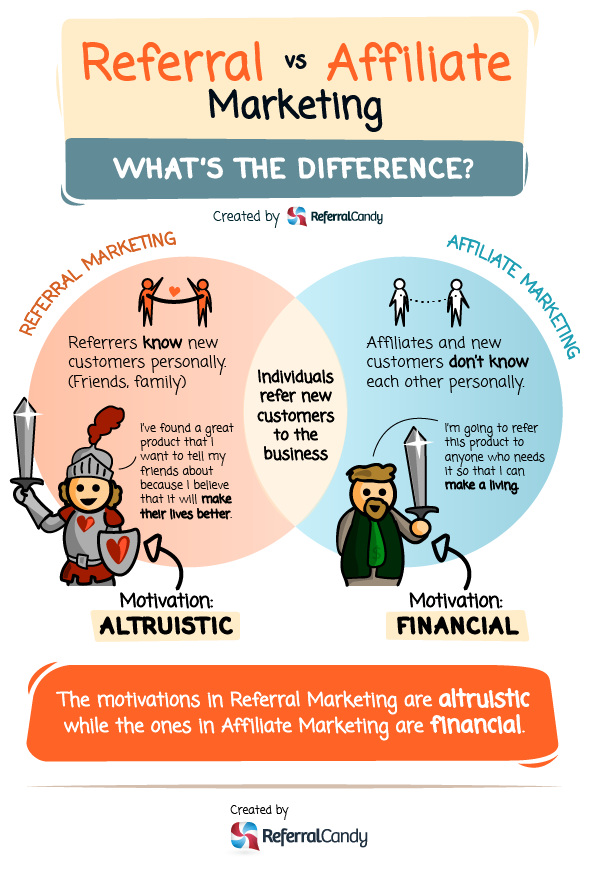
Referral programs
A referral program can be used for restaurants, cafés, or eateries to encourage spreading word of mouth. For example, you could pair this up with your strategic discounting efforts by offering customers, or potential customers, $10 off their meal when they refer a friend. This can be done through a landing page that you send to your email list subscribers. It can also be a way to gather emails if you make this offer easily visible on your website.
Referral, and loyalty, programs work great to spread awareness locally, as customers will be referring their friends and family. However, if you decide to sell any products through an ecommerce store, you could expand your reach with an affiliate program.
For more details on referral programs, you should check out ReferralCandy’s blog post.
Affiliate programs
Affiliate programs are often used when a transaction occurs online. Say you are selling recipe cookbooks online. You could set up a system that offers anyone a commission for referring someone to buy a cookbook from your website. What makes this different from a referral program is that people who sign up for affiliate programs don’t generally market to their friends and family. Most of the time it’s bloggers, YouTubers, or podcasters with online audiences that tell their viewers to use their affiliate link to purchase your products.
This makes it a great incentive for influencers, or publications, to work with you. Say you sell a recipe book for $20. You could offer 50% commissions to a publication that decides to review your book on their blog. Publications, and especially micro-influencers, will be more inclined to talk about your business if there is some sort of monetary value attached to it.
14. Advertise on Food & Drink publications, Google, and Facebook
Many restaurant publications like Eater, Grub Street, Food & Wine Magazine, Food Network, and others will have a link in their footer that says something like “advertise with us.” This means you can advertise your small business on those publications — which has a highly target audience for any food and drink business.
You could also advertise with Google Ads or Facebook ads, but you’ll have to make sure your target audience is properly set. The advantage to advertising on food and drink publications is that you’ll be advertising on a relevant website. With something like Google ads, you could bid on keywords like “best seafood in San Francisco” to have your website show up high in search results. This will be highly targeted as well because there is an intent behind the Google search, you just have to put in effort to make sure you target the right people.
With something like Facebook, you need to be strategic and target people locally. Say you just set up a takeout delivery service and you’re offering free delivery to anyone living in San Francisco. You could run a Facebook, or Instagram, ad target just people in San Francisco with a call to action.
Regardless of what you choose, any of these options are a great way to kickstart your marketing efforts. Just note that it can get fairly pricey if you don’t start seeing an immediate ROI. So be smart about your paid advertising efforts.
The turning point for restaurants, cafés, and eateries
Branding, and multiple streams of revenue, can literally save your business during tough times. As we’ve seen recently, many businesses in the food and drink industry are adopting a takeout model to continue serving their customers. While this is an important move, it’s equally as important to note the new competition that this will create. This makes branding, and your quality of food, extremely important as it will be a large factor for consumer decision making. Adopting one, or more, of the 14 ideas listed above will ensure you’re one step ahead of your competition.
Wishing your business nothing but success in the near, and long-term, future.































